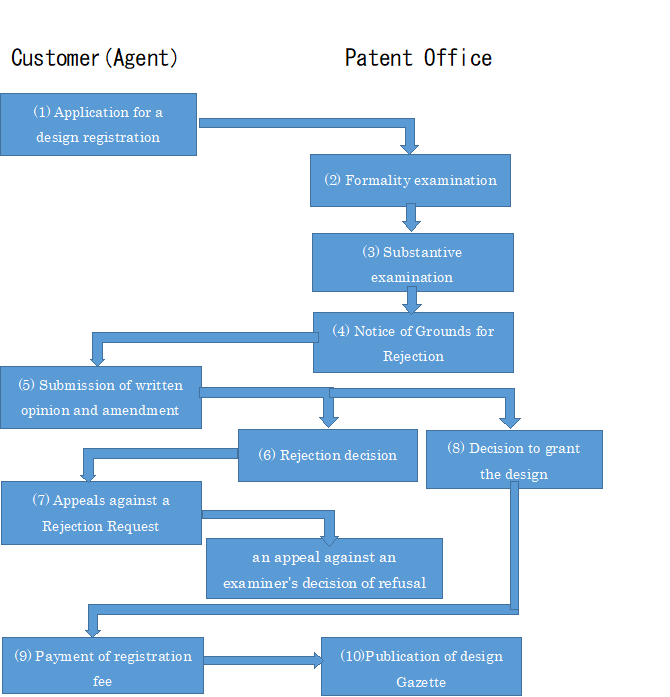For those who apply for design registration in Japan from a foreign country
When applying for design registration directly to Japan, if there is no sales office etc. in Japan, procedures by a local representative in Japan are required.
If you make an international application using the Hague system and designate Japan as a designated states, you can proceed without using a local representative in Japan under the normal procedures .
However, an applicant who does not have an address or residence in Japan can not directly submit to the Patent Office the procedure (submission of a certificate, a written opinion, an amendment, a request for fee return, etc.) based on the provisions of the Design Act. , It is necessary to select an agent who has an address or residence in Japan to carry out the procedure.
When appointing an agent, it is necessary to attach a document (a power of attorney) certifying the right of proxy and its translation to the notification of acceptance of power of attorney etc. and report it to the Patent Office.
As a local representative in Japan, we assist in acquiring design rights in Japan.
In the case of a design, we think that we can communicate with you by exchanging e-mails, but it is also possible to have a video conference if necessary.
Please see here for our video conference.
Although our office is a small office run by two patent attorneys, we offer smart services at low cost that are not available at major patent offices.
■Cost required for design registration application from foreign country to Japan
■Contact us
Convention on Designs to which Japan is a Member
Japan is a member of the following international treaties on registration of design, application procedures, etc.
(1)Paris Convention on the Protection of Industrial Property Rights
(2)Agreement on Trade-Related Aspects of Intellectual Property Rights (TRIPS Agreement)
(3)Geneva Act of the Hague Agreement concerning the International Registration of Industrial Designs
(4) Locarno Agreement
In Japan, a design system harmonized with these treaties has been established.
Basic concept of Japanese design system
First-to-file principle
The “first-to-file principle” is a system that prioritizes and registers those with earlier filing dates. If there are two or more applications for the same or similar designs, only the application of the first applicant for design registration (one on the same day) will be registered.
If the applicants are the same and they are filed on the same day, one can be registered as a principal design and a similar design as a related design (“Related Design System”).
In addition, if a later application is filed by the same person before the publication of the earlier application is issued, it can be registered by making the previous application a principal design and a similar design a related design.
Substantive examination principle
When an application for design registration is filed, substantive examinations such as novelty and creative difficulty will be conducted.
One application per design
Design registration applications must be filed for each design.
In addition, even if it is two or more articles, one that satisfies certain requirements may be recognized as “design for Set Articles”.
Processing flow of direct design registration application to Japan
The flow of processing when applying for design registration to Japan directly from overseas is the same as the flow of processing for national design registration application.

(1)Application for a design registration
■ The “design registration request” describing the prescribed matters, with the “drawing” showing the design attached, etc., will be submitted to the Commissioner of the Patent Office.
(2) Formality examination
■ The submitted documents will be checked to see if they meet the form or not.
■ If the documents are not ready or required items are not listed, order for amendment will be issued.
(3) Substantive examination
The examination will be conducted by the examiner of the Patent Office.
The examiner will decide whether or not the applied design should be registered.
(4) Notice of Grounds for Rejection
■ If the examiner finds out the reason for refusal, the examiner will deliver a notice of reasons for refusal to the applicant.
(5) Submission of written opinion and amendment
■The applicant is given the opportunity to submit a written opinion stating the objection of the refusal, and an amendment to correct the content.
(6) Rejection decision
If the examiner determines that the reasons for refusal can not be resolved by examining the written opinion or amendment, it will evaluate that the refusal should be made.
(7) Appeals against a Rejection Request
■ If you are dissatisfied with the rejection decision, you may request the Patent Office Commissioner to appeal the rejection decision.
■ Trial or appeal is conducted by a panel Consisting of either of three or five administrative judges.
■ If you are dissatisfied with the result of the appeal, you may further sue in the Intellectual Property High Court.
(8) Decision to grant the design
If no grounds for rejection are found with regard to a design application, the examiner must reach a decision to grant the design.
(9) Payment of registration fee
■ If the registration fee is paid for the application for which the registration decision has been made, the design right is registered in the design registry.
■ After registration of design right setting , the design registration certificate will be sent to the applicant.
(10) Publication of design Gazette
■ The contents of the registered design will be published in the Design Gazette.
Application to Japan under the Hague Agreement (International Design Registration Application)
Even when Japan is applied as a designated states using the Hague Agreement, the flow of application processing is almost the same as direct filing.
An international application designated as a Contracting Party for Japan is considered to be a design registration application filed with the Japan Patent Office on the date of international registration, as published in the International Design Publication and published internationally.
Also, if the international application contains multiple designs, it is considered as one design registration application for each design.
Procedures for international design registration applications to the Patent Office will be possible after international publication.
In the case of applying the provisions of exceptions to the loss of novelty, submitting a certificate of priority under the Paris Convention, or the appointment of a national representative, it is necessary to submit a document directly to the Patent Office awaiting international publication.
Those who do not have an address or residence in Japan (a foreigner) must complete these procedures through a representative who has an address or residence in Japan.
Proceeding to the Japan Patent Office after publication of the international registration
Submit priority certificate
If you claim priority at the time of international application, you will need to submit a certificate to the Japan Patent Office within three months of international publication.
Submit a certificate to apply exception to loss of novelty
If you apply for the application of exception to loss of novelty, you need to submit a certificate to the Japan Patent Office within 30 days of international publication.
Responding to a notification of rejection
If you make an opinion on the reasons for refusal indicated in the notice of the reasons for refusal, or if you revise the design of the international registration based on the reasons for refusal, you need to proceed with the Japan Patent Office.
The response period to the notice of the reasons for refusal is 3 months from the date of shipment of the Japan Patent Office (can be extended by 1 month) for those who do not have an address or residence in Japan, those who have an address or residence in Japan are 60 days from the shipping date of the Patent Office.
Duration of design protection
The duration of design protection in Japan is up to 20 years from the date of registration of the design rights setting in Japan.
For internationally registered designs that have been registered for the setting of design rights in Japan, the right to demand compensation will occur for the third party’s implementation in the period prior to the registration of the setting for design rights after international publication.o
Non-application of the secret design system
The secret design system is a system that can request that the design be kept secret for up to three years from the date of registration of the setting of the design right.
However, in the application for international design registration, the secret design system does not apply to applicants for international design registration applications, as it is impossible to keep the design secret because the contents of the national registration are made public by the International Secretariat.
However, in the case of an international design registration application, it is impossible to keep the design confidential as the content of the international registration is published by the International Bureau. Therefore, the secret design system does not apply to applicants for international design applications.
